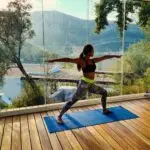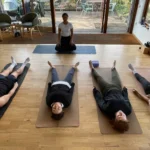Blog Post - Vinyasa Flow Essentials
Stepping into the world of Vinyasa Flow is like discovering a new rhythm in your life, one that harmonizes body and mind through mindful movement and breath. This dynamic style of yoga, often referred to as “flow,” invites you to glide seamlessly from one pose to the next, making it an ideal choice for those new to yoga or anyone seeking to deepen their practice. Vinyasa helps you build flexibility and strength while also cultivating a sense of tranquility and focus, thanks to its emphasis on breath synchronization. In this friendly guide, we’ll explore the basics of Vinyasa Flow, offering practical tips and insights to help you embark on your own yoga journey. Whether you’re aiming to improve your physical fitness, enhance your mindfulness, or simply find a peaceful moment in your day, Vinyasa Flow is ready to welcome you with open arms.
Introduction to Vinyasa Flow
What is Vinyasa Flow?
Vinyasa Flow is a dynamic yoga style that links breath with movement. It’s like a dance where each pose flows smoothly into the next, creating a continuous, fluid sequence. The word “vinyasa” means “to place in a special way” in Sanskrit, which perfectly describes this practice. In a typical class, you’ll move through a series of poses, syncing each movement with your breath. This creates a moving meditation that not only improves flexibility and strength but also calms the mind. Vinyasa is great for beginners because it’s easily adaptable to different fitness levels. You’ll often hear it called “flow yoga” due to its smooth transitions. The constant movement helps build heat in your body, boosting cardiovascular fitness and increasing flexibility. Whether you’re looking to sweat, de-stress, or find your inner zen, Vinyasa Flow offers a bit of everything for everyone.
Benefits of Mindfulness in Vinyasa
Mindfulness in Vinyasa Flow is like adding a secret ingredient to your yoga practice. As you move through poses, focusing on your breath and the present moment helps quiet the mental chatter. This mindful approach turns your practice into a moving meditation, reducing stress and anxiety. You’ll likely find yourself more centered and calm, both on and off the mat. Mindfulness also enhances body awareness, helping you tune into subtle sensations and prevent injury. It improves your focus, making it easier to stay present in challenging poses. Over time, this mindful practice can spill into your daily life, helping you react more calmly to stressful situations and make more conscious choices. Remember, it’s not about perfecting poses, but about being present in each moment. So, breathe deep, move with intention, and watch as mindfulness transforms your Vinyasa practice and your life.
Essential Poses for Beginners
Mastering Surya Namaskar
Surya Namaskar, or Sun Salutation, is the heart of Vinyasa Flow. It’s a series of 12 poses that flow together, creating a full-body warm-up that’s both energizing and grounding. As a beginner, focus on Surya Namaskar A. Start in Mountain Pose, then flow through Forward Fold, Plank, Chaturanga (lowering down), Cobra or Upward-Facing Dog, and Downward-Facing Dog. The key is syncing your breath with each movement. Inhale as you extend or lift, and exhale as you fold or lower. Don’t worry if you can’t nail every pose right away – modifications are your friends. Use your knees in Plank or Chaturanga if needed, or stick with Cobra instead of Upward-Facing Dog. With practice, you’ll build strength and flexibility, and the sequence will start to feel like a moving meditation. Remember, it’s about the journey, not perfection.
Key Poses: Warrior and Triangle
Warrior and Triangle poses are the dynamic duo of Vinyasa Flow, offering a perfect blend of strength, balance, and flexibility. In Warrior II, stand with feet wide apart, front knee bent, arms extended, and gaze over your front hand. This pose strengthens your legs and core while opening your hips and chest. It’s all about feeling grounded yet powerful. Triangle Pose, or Trikonasana, is a great hamstring stretch and side-body opener. From a wide stance, extend one arm down your leg and the other toward the ceiling. Both poses teach you to root through your feet while reaching through your fingertips, embodying that earth-to-sky connection yoga’s all about. As you practice, focus on your alignment and breath. Let each inhale create space and each exhale deepen the pose. Remember, it’s not about touching your toes or having the deepest lunge – it’s about exploring your body’s abilities with mindfulness and patience.
Cultivating Mindfulness and Flexibility
Techniques for Mindful Breathing
Mindful breathing is the secret sauce of Vinyasa Flow, keeping you present and centered during your practice. Let’s start with Ujjayi breath, often called “ocean breath” because of its soft, audible sound. To try it, slightly constrict the back of your throat as you breathe, creating a gentle hissing noise. It’s like you’re trying to fog up a mirror, but with your mouth closed. This technique slows down your breath and increases oxygen intake. Another helpful technique is belly breathing. As you inhale, focus on expanding your belly like a balloon. As you exhale, let it deflate. This deep breathing activates your body’s relaxation response. As you flow through poses, aim to maintain a steady, even breath. If you catch yourself holding your breath or breathing erratically, it’s a sign to ease back and refocus. Remember, your breath is your anchor in Vinyasa – it sets the pace and keeps you grounded in the present moment.
Embracing Flexibility with Confidence
Flexibility in Vinyasa isn’t just about touching your toes – it’s about developing a supple body and mind. As a beginner, approach flexibility with patience and self-compassion. Everyone’s body is different, and progress happens gradually. Focus on how each pose feels rather than how it looks. Use props like blocks or straps to support your practice and prevent overstretching. They’re not cheating; they’re tools to help you grow. Pay attention to your breath – if it becomes strained, you may be pushing too hard. Back off a bit and find your edge, that sweet spot between effort and ease. Remember, gentle, consistent practice will yield better results than forcing yourself into pretzel-like positions. Celebrate small victories, like reaching a little further each week. With time, you’ll notice not just physical flexibility, but mental flexibility too – adapting more easily to life’s twists and turns.



